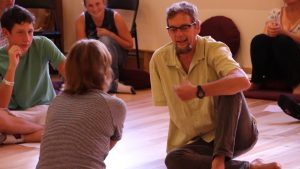29 The CLARA Approach to Difficult Conversations
“In the case of dissension, never dare to judge till you’ve heard the other side.”– Euripides
Euripides (484 BCE – 406 BCE) was a playwright from Athens. He was one of only three ancient Greek tragedians who had plays that survived. His quote shows how long certain conflict resolution strategies have existed. Understanding the other side is an essential piece of advice you’ll see over and over again. You can only judge once you know what the other side is saying. Judging beforehand – without all the information or other perspectives – makes it much harder to resolve a conflict.
“Peace is not the absence of conflict, but the ability to cope with it. ” –Mahatma Gandhi
Gandhi (1869-1948) was an Indian lawyer and anti-colonialist who relied on nonviolent resistance. As a leader in the campaign for India’s independence from the British, other human rights movements around the world embraced his words and tactics. This quote reframes what many may believe about “peace” and emphasizes a person’s response to conflict. –peace career conflict resolution
The CLARA approach to engaging in difficult conversations is part of a Conflict Transformation strategy utilized by Dr. Randy Janzen as part of Peace Studies education. I first encountered this activity when Randy facilitated a session on communication skills for a group of students and community leaders at Selkirk College. The CLARA model was created by the pacifist Quaker organization, American Service Friends Committee.
The acronmyn C.L.A.R.A. stands for Calm, Listen, Affirm, Respond and Add. Each of these steps helps in the process of creating a respectful dialogue about tricky issues. Like many communication skills, they sound deceptively simple, but putting them into practice is challenging.
Purpose
The purpose of this activity is to give participants a chance to observe and then practice a model for listening to someone who has a different point of view.
Learning Objectives
Participants will:
- Observe two people discussing a controversial situation using the CLARA method.
- Describe the steps of CLARA for engaging in a challenging conversation.
- Practice the steps of CLARA in a dialogue about a controversial topic.
Activity Directions
Set-Up: Chairs in a horseshoe with two chair facing each other at the front of the room.
- Choose a topic ahead of time: Facilitator chooses a topic that they know is controversial in the community. Ahead of the session they approach a co-facilitator or participant about engaging in a conversation together.
- Hand-Out: Print the following Hand-Out so that each participant can be watching for these approaches as they observe the interaction.
- Demonstration conversation using the C.L.A.R.A. approach: Engage for 15 minutes in a conversation with the designated partner about a controversial topic using the C.L.A.R.A. approach.
- Full Group Discussion: Debrief the interaction by asking for observations and examples of how the facilitator demonstrated each of the CLARA steps.
- Propose a controversial topic: We have used topics like abortion, capitol punishment, drug legalization and vaccination. It is good to choose a juicy topic where there are strong feelings.
- Divide the group in half and tell one group they will have strong feelings on one side of the issue and the other group will support the other side of the issue.
- Form dyads with people who disagree: Ask the each group to form dyads with one from each side of the issue. If the room does not divide evenly, some people may need to role-play a position they don’t agree with.
- Practice using the C.L.A.R.A. steps to listen to another person’s point of view: Use the C.L.A.R.A. method to listen to talk with each other about the issue. In this exercise, both people are speaking and using the C.L.A.R.A. approach to try to fully understand the other person’s position.
- Full Group Debrief: What was your experience of listening and affirming and trying to find some common ground with someone with a different opinion? What other experiences did you have as you tried to implement the C.L.A.R.A. model? Which part was the most challenging for you? How might you use this approach in your personal or professional life?
CASE Study: C.L.A.R.A. Approach to Difficult Conversations
As part of an overall leadership training program for new residence advisors, Randy Janzen offered a workshop on conflict transformation. At that point in time there were very strong feelings about an oil pipeline that was proposed to cross from Alberta to the west coast of British Columbia. Randy proposed this issue for discussion. If people did not have strong opinions on this subject, they were asked to role-play a position for or against the pipeline.
C = Calm
Take a moment to acknowledge your feelings (anger, upset, fear . . . .) Take a deep belly breath followed by a long out breath. Just notice your body, your mind and your environment. Let your nervous system slow down and do your best to listen from a place of non-judgmental curiosity.
Speak when you are angry, and you’ll make the best speech you’ll ever regret.” – Lawrence Peter
L = Listen
“I wonder if we’ve had the same experiences with ______________________”
Try to really understand what they are saying. (Don’t fall into the trap of “waiting to speak). See if you can imagine how they experience the world and what their opinion means to them. What are the deeper needs and values that has shaped their opinion?
“I’ve never learned a thing while talking.” – Larry King
A = Affirm
Try to find common ground through any shared experiences or feelings. See if you can recognize the underlying human needs that drive their positions. Put what they have said in your own words so they know that you are really working to understand their point of view.
Acknowledge what they said before you respond with your thoughts. This can be done through restating and summarizing key points and emotions you heard.
In our leadership retreat we practiced responding to controversial topics with empathic responses that captured the emotional and intellectual content:
Example: “So you believe the Keystone Pipeline will totally benefit Canadians with jobs and it frustrates you when people in B.C. seem to want their cars and oil based lifestyles, yet protest all the positive developments.”
You can only proceed when you observe that the person has calmed down and seems willing to listen. Until this happens, you need to repeat steps one to three, Calm, Listen, Affirm until you are both in a place where you can hear each other.
R = Respond
Respond to the exact concerns that the person has raised. This may be again repeating or paraphrasing their message. State your thoughts in a compassionate way.
A = Add
When the other person feels fully heard and is ready to listen, add something about how you see the topic. Help the other person to consider the issue in a new light, or redirect the discussion in a more positive direction.
* Use description instead of evaluation:
For instance:
*State needs instead of positions:
*State feelings instead of thoughts and the other person is more likely to be able to hear you:
Case Study: Selkirk College Residence Advisors Leadership Training

The C.L.A.R.A. practice session led into talking about leadership skills and ways that student leaders can de-escalate tensions when there are conflicts on campus.
SOURCE

“Turn judgement into curiosity.” -Dr. Randy Janzen
Gain deeper insights and skills on how to analyze and transform conflicts, with Randy’s book:

“Dr. Randy Janzen’s book provides students, activists, community organizers and the general public with a concise and clear guide on how to approach, analyze and address conflict in order to transform relationships and work towards peace with justice. In doing so, it details a systematic process to analyze conflict, and offers an understandable framework in which to situate and choose strategies of building cultures of peace. It acknowledges the academic divide between the disciplines of peace studies and conflict resolution studies, yet is relevant to students of both fields. The volume draws on relevant theory and research from sociology, psychology, critical studies and anthropology, and starts from the assumption that conflict analysis and transformation must include a critical analysis of hegemony and power.”
Additional Resource
The Soliya organization has wonderful facilitator training programs and resources for engaging in challenging conversations:


